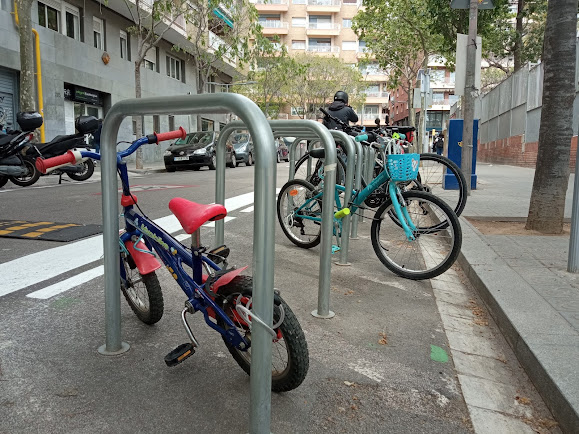Urban on-street bike parking might have been an afterthought in the past, but increasingly cities will need better data on who, when and how residents are using on-street bike parking facilities. Which neighbourhoods are at capacity? Which areas need more facilities? What is the temporal dynamics and diurnal-noctural fluctuations? Where are the conflicts between pedestrians and illegally parked bicycles? Where are spots occupied by private bike-share programs? What about scooters? Or abandoned bikes? And what about kid bikes? How present are they in the urban cycling mix? And on average, how long do bikes stay in the on-street spots? Are they for day use? night use? or long term use? In this post I present some preliminary data with research conducted with Sofie Dejaegher, Esteve Corbera and Victoria Ortega, on urban on-street bike parking in Barcelona, with data collected between February and July 2021. Our journal article will come out later, but here are a few illustrative figures that start to tell the story of what we are seeing from our field data.
Informal or illegal bike parking in Gràcia (c/Joan Blanques). Gràcia showed the most number of illegally parked bikes and the highest occupancy rate of on-street bike parking.
Bike parking at 100% capacity in Plaça Rovira, Gràcia.
An empty bike parking location in Les Corts, accompanied by two guardian motorcycles.
Squeezing in bike parking in Gràcia, Barcelona.
First, we see that Gràcia and Ciutat Vella (Old City) have the highest average occupancy. This is the average occupancy of all the bike parking sites (punts d'ancoratge) in our sample plot, so the average of 81% occupied in Gracia means most sites in Gràcia close to capacity and several were over 100%. Ciutat Vella is the other neighbourhood with symptoms of an on-street bike parking problem, as it showed an average occupancy of 74%. The districts of Sant Marti, Eixample and Sants all show high use as well.
And this is what the data looks like when you map it.
The map shows us that there appears to be more bikes along the two central axis of the city (Old City to Gracia + Coastal axis), with the periphery having substantially less use. Interestingly, the two ears of the city (Les Corts & Nou Barris) have the opposite socio-economic status, so what explains on-street bike parking probably has more to do with geography and topography than income.
If we only look at the number of total spots available in our sample plots, we can infer that bike parking is not distributed evenly throughout the city. Neighbourhoods with high use have many more spots. But we also see that Eixample has more spots, even though Gracia has higher use. So high occupancy correlates with infrastructure availability, suggesting that the city is being responsive to demand, but there still appears to be unmet demand in Gràcia and Ciutat Vella.
What sort of bikes did we find in the bike racks? Is it true that bike racks are being overwhelmed by the shared bikes from private companies? Well, at a city wide scale, that does not appear to be the case. However we should be careful to note that a district wide analysis may hide intense use at particular sites.
We see lots of children bikes in Sant Marti and Ciutat Vella, and to some extent in Gràcia and Eixample. In some cases, we sensed that the children bikes were being parked for long term storage in the on-street facilities, but in other instances it was inspiring to see that kids were really using the on-street parking for day use, indicating that children and parents feel safe enough to bike the city.
This project is just the beginning of more work on bike parking in Barcelona. We hope to contribute to this issue with new data, since until recently, no one even bothered to examine occupancy rates and use of this critical cycling infrastructure. This issue is also timely, coming on the heels of the CicloBCN21 conference and has been picked up by Michele Catanzaro from El Periodico, who has written a thoughtful feature article using some of our data as the entry point to the topic.
I will end with a few photographs from our field work throughout the city.
An empty bike parking location in Les Corts, accompanied by two guardian motorcycles.
We found several spots that had a very large capacity, especially near transit stops or schools. These are probably designed to cover peak hours. Photo in Sant Andreu, Barcelona.
Bike parking facilities in Horta, Barcelona.








Comments
Post a Comment